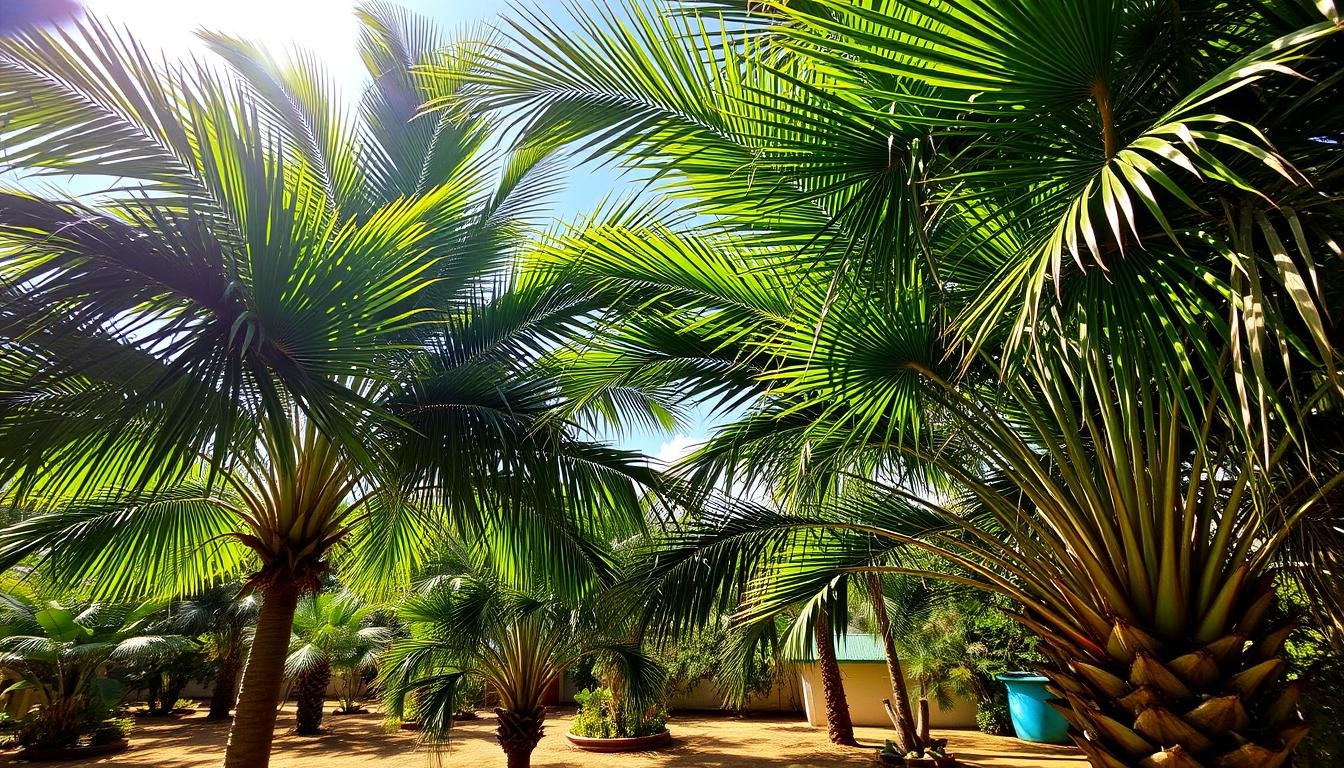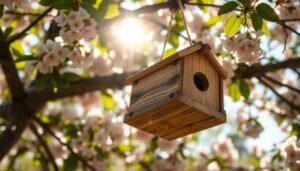Key Takeaways
- Areca palms are not annual plants, but rather long-lived perennials that can thrive for many years with proper care.
- The lifespan of an areca palm can range from 10 to 20 years or more, depending on factors such as growing conditions and maintenance.
- Areca palms have specific care requirements, including regular watering, well-draining soil, and exposure to bright, indirect sunlight.
- There are several varieties of areca palms, each with its own unique characteristics and growth habits.
- Proper pruning and maintenance are essential for keeping areca palms healthy and vibrant over time.
Table of Contents
What are Areca Palms?
Areca palms, also known as Dypsis lutescens, come from the lush island of Madagascar. They belong to the Arecaceae family. These palms are known for their slender trunks and long, feathery fronds that can reach up to 6 feet.
Origin and Classification
Areca palms are from the tropical regions of Madagascar. They love the warm, humid climate. These palms are part of the areca palms category, which includes many species in the Arecaceae family.
Physical Characteristics
Areca palms have beautiful, feather-like leaves. Their fronds can grow very long, with many delicate, lance-shaped leaflets. This creates a stunning, cascading effect. Their trunks are slender and ringed, adding to their elegance.
These palms can grow in many climates, making them great for both indoor and outdoor spaces. With their long areca palms lifespan and variety of types of areca palms, they add beauty to any garden or room.
Are Areca Palms an Annual Plant?
No, areca palms are not annual plants. They are tropical beauties that live for more than two years. They keep growing and making new fronds forever. With the right care, areca palms can live for decades.
Unlike annual plants, areca palms are perennial. They can live and grow year after year. They get bigger and more beautiful as they get older. This makes them a favorite for gardens and homes.
“Areca palms are known for their lush, graceful foliage and ability to adapt to a wide range of growing conditions, making them a versatile and long-lasting addition to any plant collection.”
Areca palms shed old fronds but always grow new ones. This keeps them looking green and lively all year. Their growth pattern is different from annual plants.
To sum up, areca palms are not annual plants. They are tropical wonders that can brighten our spaces for years.
Areca Palms Lifespan
Areca palms can live a long time, up to 10-15 years indoors. But, their lifespan depends on a few important things.
Factors Affecting Longevity
The life of an areca palm is affected by many things. These include:
- Watering and soil quality: The right amount of water and soil nutrients are key.
- Lighting conditions: They need bright, indirect light to grow well. Too little light can hurt their growth.
- Temperature and humidity: They like warm, humid places. Cold or dry air can harm them.
- Pest and disease management: Keeping them safe from pests and diseases is important.
- Variety and genetics: Some palms are naturally longer-lived than others.
By taking care of these things, you can help your areca palm live a long, healthy life.
“The secret to a long-lived areca palm is creating the ideal environment for it to flourish.”
Caring for Areca Palms
Keeping your areca palm healthy is important. These plants need the right care for water, soil, light, and temperature.
Watering and Soil Requirements
Areca palms love moist, well-draining soil. Water them often, but don’t let the soil get too wet. Make sure the pot has holes to drain water.
Use a mix made for palms or a mix of peat moss, perlite, and compost. This mix keeps the soil moist but also lets it breathe.
Light and Temperature Needs
Areca palms need bright, indirect light. They do best near sunny windows or in rooms with filtered light. Direct sunlight can hurt their leaves.
These palms like temperatures between 60°F and 85°F. Avoid big changes in temperature to keep them happy.
| Areca Palm Care Needs | Requirements |
|---|---|
| Watering | Consistently moist, well-draining soil |
| Soil | Palm-specific potting mix or blend of peat moss, perlite, and compost |
| Light | Bright, indirect sunlight |
| Temperature | 60°F to 85°F |
Give your areca palm the right care to help it grow well. Pay attention to its water, soil, light, and temperature needs. This will keep your plant healthy and beautiful.
Types of Areca Palms
Areca palms, also known as the yellow palm or butterfly palm, come in many types. Each has its own special features. These types of areca palms are great for adding a tropical feel to homes and gardens.
The standard areca palm (Dypsis lutescens) can grow up to 30 feet tall. It has long, feathery fronds. The dwarf areca palm (Dypsis decaryi) is smaller, reaching 10-15 feet. Its leaves are rounded and fan-shaped, adding beauty to any space.
The butterfly areca palm (Dypsis prestoniana) is a standout. It has leaves that look like butterfly wings. This makes it a great conversation starter in gardens.
- Standard areca palm (Dypsis lutescens)
- Dwarf areca palm (Dypsis decaryi)
- Butterfly areca palm (Dypsis prestoniana)
Every type of areca palm needs the same basic care. This makes them easy to grow indoors or outdoors. Their beauty and ease of care make them a favorite among plant lovers.
“Areca palms show the beauty and variety of nature. Each type has its own charm, making them essential for any plant enthusiast.”
Areca Palm Growth Rate

Areca palms are known for their lush, feathery fronds. They are medium-growing plants, growing 12-24 inches per year. But, their growth can change based on many factors.
Things like the environment and how well you care for the plant can affect their growth. You can learn more about areca palm growth here.
Factors Influencing Growth
The light the plant gets is a big factor in areca palm growth rate. They love bright, indirect sunlight. This helps them grow faster.
Keeping the right temperature and humidity is also important. So is using good soil and making sure it has the nutrients it needs. All these things help the plant grow well.
| Factor | Impact on Areca Palm Growth Rate |
|---|---|
| Light Exposure | Bright, indirect sunlight promotes faster growth |
| Temperature | Warm, consistent temperatures (70-85°F) support optimal growth |
| Humidity | High humidity levels (60-80%) help prevent stagnation and encourage lush foliage |
| Soil Quality | Well-draining, nutrient-rich soil allows for robust root development and overall vigor |
By knowing and taking care of these important factors, gardeners can help their areca palms grow well. This makes the plants look vibrant and adds a tropical touch to any space.
“Proper care and attention to the environmental needs of areca palms can unlock their full growth potential, allowing them to reach their maximum height and lushness.”
Propagating Areca Palms
If you love growing areca palms, you might want to try propagation. There are two main ways to do this: division and seed propagation. Let’s explore each method for areca palm propagation.
Division of Offsets
Division is a simple way to grow more areca palms. It means taking the offsets or “pups” from the main plant and putting them in their own pots. First, take the plant out of its pot. Then, find the offsets and carefully cut them off with a sharp knife or pruners.
Make sure each offset has a strong root system. Then, put it in well-draining, slightly acidic soil.
Seed Propagation
Seed propagation is another way to grow areca palms. It’s cheaper but takes longer. Start by collecting seeds from a mature palm. Plant them in a seed-starting mix.
Keep the soil moist and the area bright but filtered. Wait for the seeds to germinate. Once they have a few leaves, move them to their own pots. Treat them like a full-grown areca palm.
| Propagation Method | Advantages | Disadvantages |
|---|---|---|
| Division |
|
|
| Seed Propagation |
|
|
Choose the areca palm propagation method that works for you. Make sure to give your new plants the right care. With patience and effort, you can grow more areca palms and share them with others.
“Propagating areca palms is a rewarding way to grow your collection and share these stunning plants with others.”
Pruning and Maintenance
To keep your areca palms healthy, you need to prune and maintain them regularly. Knowing when and how to prune is key.
When to Prune
The best time to prune areca palms is in the spring or early summer. This is when the plant grows the most. It’s a good time to remove dead or damaged fronds for new growth.
How to Prune
- Use clean, sharp pruning shears or scissors to avoid damaging the plant.
- Cut the fronds at the base, close to the trunk, making a clean, angled cut.
- Avoid cutting too close to the trunk, as this can lead to further damage or disease.
- Dispose of the pruned fronds properly to prevent the spread of any issues.
Proper pruning keeps your areca palms looking good and healthy. It also stops pests and diseases. By removing unwanted growth, you help your palms grow strong and vibrant.
“Regular pruning is essential for the long-term health and appearance of areca palms. By staying on top of maintenance, you can ensure your plants thrive for years to come.”
Conclusion
We’ve looked into the world of Areca Palms, learning about their beginnings, traits, and how they grow. Areca Palms are not yearly plants. They live for many years with proper care.
This guide has given you key tips on watering and soil for Areca Palms. It also showed you the different types. By using the pruning and care tips, your palms will stay healthy and beautiful.
As we end this journey, I hope you’re ready to add Areca Palms to your space. They bring beauty and life to any area. This article is a great help for anyone, whether you’re new to plants or have been growing them for years.




